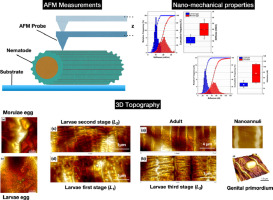当前位置:
X-MOL 学术
›
Ultramicroscopy
›
论文详情
Our official English website, www.x-mol.net, welcomes your feedback! (Note: you will need to create a separate account there.)
Assessment of Biophysical Properties of Haemonchus contortus from Different Life Cycle Stages with Atomic Force Microscopy
Ultramicroscopy ( IF 2.2 ) Pub Date : 2020-02-01 , DOI: 10.1016/j.ultramic.2019.112862 Livio M Costa-Junior 1 , Carolina R Silva 1 , Alexandra M S Soares 2 , Alan S Menezes 3 , Maria R L Silva 4 , Alessandro F T Amarante 4 , Erivelton F Costa 5 , Luciana M R Alencar 3
Ultramicroscopy ( IF 2.2 ) Pub Date : 2020-02-01 , DOI: 10.1016/j.ultramic.2019.112862 Livio M Costa-Junior 1 , Carolina R Silva 1 , Alexandra M S Soares 2 , Alan S Menezes 3 , Maria R L Silva 4 , Alessandro F T Amarante 4 , Erivelton F Costa 5 , Luciana M R Alencar 3
Affiliation

|
Atomic force microscopy (AFM) was used in this work to investigate the ultrastructural and mechanical characteristics of Haemonchus contortus, the major gastrointestinal nematode that infects small ruminants worldwide. The biophysical characterization of this species is extremely important in order to reveal mechanisms of action of drugs and to classify its ultrastructure and biomechanical properties. High-resolution topographic images by AFM as well as data on biomechanical properties of cuticles were obtained at different stages of H. contortus. The results reveal details of the mechanical and structural properties of this nematode never observed before for nematodes parasite with other microscope techniques. Qualitative and quantitative reductions in the elasticity of the larvae stage egg were compared with those of the morulae stage, and the increased adhesion of unsheathed L3 were compared with the same stage of sheathed larvae. The results presented here open possibilities for understanding the mechanisms of drug and biomolecular actions that can be used to control infections caused by H. contortus.
中文翻译:

用原子力显微镜评估不同生命周期阶段的 Haemonchus 的生物物理特性
在这项工作中使用原子力显微镜 (AFM) 来研究扭曲血球虫的超微结构和机械特征,这是一种感染全球小型反刍动物的主要胃肠道线虫。该物种的生物物理特征对于揭示药物的作用机制并对其超微结构和生物力学特性进行分类非常重要。在扭曲变形虫的不同阶段获得了 AFM 的高分辨率地形图像以及角质层生物力学特性的数据。结果揭示了这种线虫的机械和结构特性的细节,以前从未用其他显微镜技术观察到线虫寄生虫。将幼虫期卵弹性的定性和定量降低与桑椹期相比,与同期有鞘幼虫相比,未出鞘的L3的粘附增加。此处呈现的结果为了解可用于控制由扭曲变形杆菌引起的感染的药物和生物分子作用机制提供了可能性。
更新日期:2020-02-01
中文翻译:

用原子力显微镜评估不同生命周期阶段的 Haemonchus 的生物物理特性
在这项工作中使用原子力显微镜 (AFM) 来研究扭曲血球虫的超微结构和机械特征,这是一种感染全球小型反刍动物的主要胃肠道线虫。该物种的生物物理特征对于揭示药物的作用机制并对其超微结构和生物力学特性进行分类非常重要。在扭曲变形虫的不同阶段获得了 AFM 的高分辨率地形图像以及角质层生物力学特性的数据。结果揭示了这种线虫的机械和结构特性的细节,以前从未用其他显微镜技术观察到线虫寄生虫。将幼虫期卵弹性的定性和定量降低与桑椹期相比,与同期有鞘幼虫相比,未出鞘的L3的粘附增加。此处呈现的结果为了解可用于控制由扭曲变形杆菌引起的感染的药物和生物分子作用机制提供了可能性。



























 京公网安备 11010802027423号
京公网安备 11010802027423号